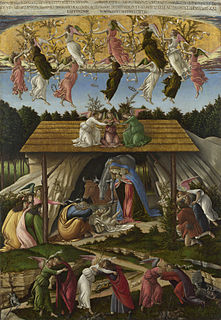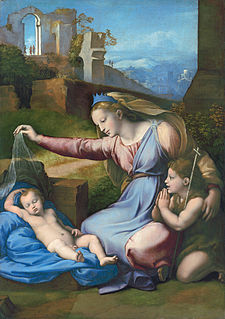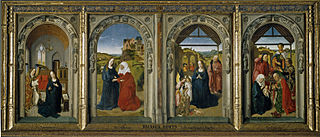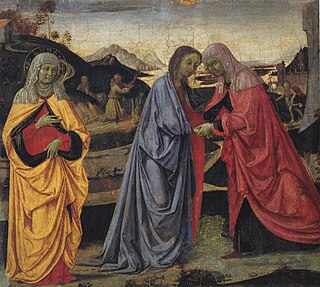
Lorenzo Monaco was an Italian painter of the late Gothic to early Renaissance age. He was born Piero di Giovanni in Siena, Italy. Little is known about his youth, apart from the fact that he was apprenticed in Florence. He was influenced by Giotto and that artist's followers Spinello Aretino and Agnolo Gaddi.

Robert Campin, now usually identified with the Master of Flémalle, was the first great master of Early Netherlandish painting. While the existence of a highly successful painter called Robert Campin is relatively well documented for the period, no works can be certainly identified as by him through a signature or contemporary documentation. A group of paintings, none dated, have been long attributed to him, and a further group were once attributed to an unknown "Master of Flémalle". It is now usually thought that both groupings are by Campin, but this has been a matter of some controversy for decades.

Pietro Perugino, born Pietro Vannucci, was an Italian Renaissance painter of the Umbrian school, who developed some of the qualities that found classic expression in the High Renaissance. Raphael was his most famous pupil.

Petrus Christus was an Early Netherlandish painter active in Bruges from 1444, where, along with Hans Memling, he became the leading painter after the death of Jan van Eyck. He was influenced by van Eyck and Rogier van der Weyden and is noted for his innovations with linear perspective and a meticulous technique which seems derived from miniatures and manuscript illumination. Today, some 30 works are confidently attributed to him. The best known include the Portrait of a Carthusian (1446) and Portrait of a Young Girl ; both are highly innovative in the presentation of the figure against detailed, rather than flat, backgrounds.

The Mystical Nativity is a painting in oil on canvas dated c. 1500–1501 by the Italian Renaissance master Sandro Botticelli, in the National Gallery in London. It is his only signed work and has an unusual iconography for a painting of the Nativity.
Nativity or The Nativity may refer to:

The Nativity of Jesus has been a major subject of Christian art since the 4th century.

The Life of the Virgin, showing narrative scenes from the life of Mary, the mother of Jesus, is a common subject for pictorial cycles in Christian art, often complementing, or forming part of, a cycle on the Life of Christ. In both cases the number of scenes shown varies greatly with the space available. Works may be in any medium: frescoed church walls and series of old master prints have many of the fullest cycles, but panel painting, stained glass, illuminated manuscripts, tapestries, stone sculptures and ivory carvings have many examples.

The Madonna with the Blue Diadem is a painting by Raphael and his pupil Gianfrancesco Penni, and was most likely painted in Rome around 1510-1512, now at the Louvre. In the Louvre, the painting is named Virgin and Child with the Infant Saint John, also known as Virgin with the Veil or Virgin with the Blue Diadem. Additional names include Virgin with the Linen, Slumbering Child and Silence of the Holy Virgin.

The Nativity at Night or Night Nativity is an Early Netherlandish painting of about 1490 by Geertgen tot Sint Jans in the National Gallery, London. It is a panel painting in oil on oak, measuring 34 × 25.3 cm., though it has been cut down in size on all four sides. The painting shows the Nativity of Jesus, attended by angels, and with the Annunciation to the shepherds on the hillside behind seen through the window in the centre of the painting. It is a small painting presumably made for private devotional use, and Geertgen's version, with significant changes, of a lost work by Hugo van der Goes of about 1470.

The Adoration of the Shepherds is a painting by the northern Italian Renaissance artist Andrea Mantegna, dated to c. 1450-1451.

The Annunziata Polyptych is a painting cycle started by Filippino Lippi and finished by Pietro Perugino, whose central panel is now divided between the Galleria dell'Accademia and the Basilica dell'Annunziata, both in Florence, Italy. The polyptych had other six panels, which are housed in the Lindenau-Museum of Altenburg, the Metropolitan Museum of New York City, the Galleria Nazionale d'Arte Antica in Rome and in a private collection in South Africa.

The Annunciation with St. Margaret and St. Ansanus is a painting by the Italian Gothic artists Simone Martini and Lippo Memmi, now housed in the Uffizi Gallery in Florence, Italy. It is a wooden triptych painted in tempera and gold, with a central panel having double size. Considered Martini's masterwork and one of the most outstanding works of Gothic painting, the work was originally painted for a side altar in the Siena Cathedral.

Zanobi di Benedetto di Caroccio degli Strozzi, normally referred to more simply as Zanobi Strozzi, was an Italian Renaissance painter and manuscript illuminator active in Florence and nearby Fiesole. He was closely associated with Fra Angelico, probably as his pupil, as told by Vasari. He is the same painter as the Master of the Buckingham Palace Madonna. Most of his surviving works are manuscript illuminations but a number of panel paintings have also been attributed to him, including seven altarpieces and six panels with the Virgin and Child, along with some designs for metalwork.

Triptych of the Virgin's Life is an oil on panel painting by the Early Netherlandish painter Dieric Bouts. It was executed circa 1445 and is in the collection of the Museo del Prado, in Madrid.

The Bladelin Altarpiece, or Middelburg Altarpiece, is a triptych painting created around 1450 by the Flemish painter Rogier van der Weyden, towards the end of his artistic career. The work depicts scenes relating to the birth of Jesus; it is the only nativity scene definitively attributed to van der Weyden, and so is also known as the Nativity Triptych. It was donated to the new church of the town of Middelburg in 1460, possibly by Pieter Bladelin, who founded the town. It has been in the Gemäldegalerie, Berlin, since 1834.

Two small paintings in London and New York are believed to come from the same predella, and are attributed to Zanobi Strozzi, a Florentine painter who was probably a pupil of Fra Angelico. They are an Adoration of the Magi in the National Gallery in London, and a Nativity in the Metropolitan Museum of Art in New York. They date to about 1433–34 and are in tempera and gold on panel.

Nativity of the Virgin is a small painting in tempera on panel by Pietro Perugino, dating to around 1472 and now in the Walker Art Gallery in Liverpool. It shows the nativity of Mary. The style of the house is heavily influenced by Andrea del Verrocchio.

Miracle of the Snow is a painting in tempera on panel by Pietro Perugino, dating to around 1472–1474 and now in the collection of Polesden Lacey. It shows the miraculous fall of snow which marked the spot for the foundation of Santa Maria Maggiore in Rome in 352. https://en.wikipedia.org/w/index.php?title=Miracle_of_the_Snow&action=edit The painting belongs to Perugino's early period and the important commissions he gained during the short time he was active in Florence. Both it and the Nativity of the Virgin are usually identified as one of two surviving parts of the same predella, either from a lost altarpiece of the Virgin Mary or from the Pala di San Martino a Strada by Andrea del Verrocchio's studio. Both predella panels were in the Pucci chapel in Santissima Annunziata in Florence by 1786, when they were bought by John Campbell. They were sold to different owners in London in 1804, with the Miracle entering the Polesden Lacey collection.

Visitation is a tempera on panel painting usually attributed to Perugino, executed c. 1472–1473, now in the Galleria dell'Accademia in Florence. An early work by the artist from around the same time as Nativity of the Virgin, whilst he was still heavily influenced by Andrea del Verrocchio, it probably originated as part of the predella for a lost altarpiece. It shows the Visitation, with the Virgin Mary's mother Saint Anne to the left. In the left background is Francis of Assisi receiving the stigmata and in the right background is Florence's patron saint John the Baptist - this may indicate that the lost altarpiece was intended for a Franciscan monastery in Florence such as Santa Croce.



















